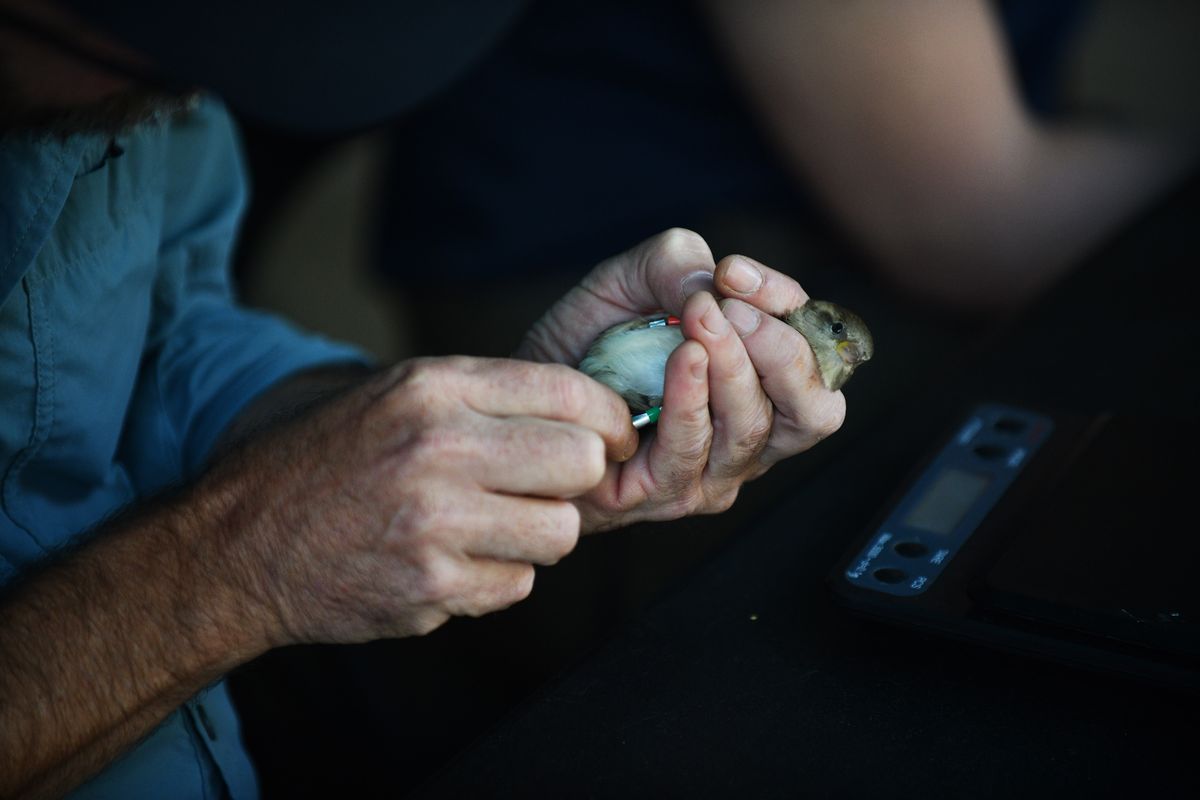National Zoo’s bird-banding helps track movement, decline

Outside the National Zoo’s Bird House, small white cotton bags hung on hooks, each holding a bird that ornithologist Brian Evans and his team had netted that Saturday morning. Now and then, they squirmed nervously, their feathers rustling as a rapt audience of birders waited.
Evans gently lifted one of the bags off its hook and put his hand inside.
“So you guys are going to be pretty excited about this. … It is a glorious, exotic bird,” Evans said with a hint of comedy as he pulled it out of the bag like a magician.
The birders giggled on seeing the calm, quiet bird, a few of them blurting out, “A house sparrow!” It is one of the most commonly seen birds in the Washington, D.C., region even though it is nonnative – originally from Eurasia – and considered invasive, said Evans, an ornithologist at the Smithsonian’s National Zoo and Conservation Biology Institute.
Evans expertly wrapped its leg with a lightweight aluminum tag – bearing a unique number, like a license plate – and a few colorful plastic bands for his team and the public to be able to easily identify the bird through binoculars.
The zoo’s Saturday-morning bird-banding demonstration – held privately that day for the DC Bird Alliance but normally open to the public – is part of the zoo scientists’ efforts to determine the causes of bird decline and steps to help mitigate the staggering loss. North America has lost about a third of its bird population – nearly 3 billion birds – in 50 years.
The bands help the ornithologists monitor individual birds and their survival.
“Our ultimate goal is to be able to both understand how birds respond to human-managed landscapes and be able to provide science-based solutions for helping save the birds,” Evans and his colleague Tara Snedgen said via email.
The zoo has held bird-banding demonstrations since 2017. They were halted during the pandemic but started up again in March 2023 after the zoo’s refurbished Bird House reopened. Evans and Snedgen said more than 1,000 birds have been banded at the zoo since the program began.
The scientists typically band one or two birds at each demonstration, which – weather permitting – is held at the Bird House every Saturday at 10 a.m. The scientists also band birds at the Smithsonian Environmental Research Center in Edgewater, Md., and the Smithsonian Conservation Biology Institute in Front Royal.
Soon, Evans and Snedgen said, the zoo plans to invite visitors to search for the color-banded birds and submit their observations through an app. The team is also installing a bird-feeder camera and a linked app so that people can watch the live stream and submit observations from their homes.
“During the testing phase, this app was a huge success,” Evans and Snedgen said by email, adding that they got over 3,000 identifications of color-banded birds in five months.
They plan to launch public efforts to find and report the color-banded birds once employees are able to locate them at a rate of five birds per hour, to ensure that the public will be able to easily find them, too.
After banding the house sparrow, Evans used a ruler to measure its wing and tail. With bird in hand, he walked around his audience to give them a closer view. Then he went to a nearby area with shrubs, opened his hand, and it bolted off.
Unlike the house sparrow, which Evans called “very nice,” the next bird was a “big personality,” squawking loudly – for a small bird, that is – as Evans pulled it out of the bag. It was a tufted titmouse, a native bird with a pointy gray crest atop its head.
“They cause trouble in the environment, sometimes good trouble. If they see something that’s dangerous, like a cat, they go around and squawk at it, and the other birds will come in and mob. But these guys will be the start of the mob,” Evans said as the titmouse nipped at his fingers. “We need sentinels like this titmouse to go and cause trouble to reduce the probability of predation of others.”
After it was banded, the audience leaned in for a look at the bird before Evans let it go. It flew to a small tree and perched on a branch.
Evans, who has been banding birds since 2007, said his research over the years has yielded some unexpected findings. For example, he was surprised to discover higher rates of adult bird and nestling survival at urban sites than at rural sites. Given the number of hazards birds face in cities, he had expected the opposite to be true.
Evans and Snedgen closed their demonstration with a discussion about birds killed by outdoor cats and window collisions. In the United States, outdoor cats kill more than a billion birds each year, according to a study published in 2013, and a recent study found more than a billion birds die each year after crashing into buildings. The scientists recommended keeping cats indoors and treating windows so they’re visible to birds.
They also emphasized the importance of growing native plants to support caterpillars that local birds rely on for food.
Delivering these messages is a key reason the zoo ornithologists hold the weekly program.
“It’s an activity to get people engaged in conservation and empower them to make changes that are going to positively impact birds,” Evans said after the audience left. “The biggest challenge we face is nihilism – thinking there’s nothing we can do. … It’s bogus. We want to empower people to believe they can make a difference.”